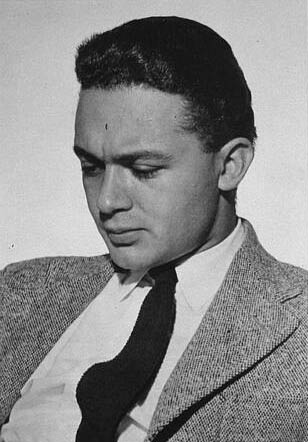
The name Paul Rand is synonymous with modern graphic design. His minimalist and corporate style of logo design and typography influenced a generation of artists who followed, creating a lasting impression on the industry for decades to come. Born on August 15th, 1914 in Brooklyn, New York, Rand personified success from an early age.
Paul Rand: Early Years
Peretz Rosenbaum, better known as Paul Rand, was born in Brooklyn, New York and had a passion for art from an early age. He studied in New York City and worked as an art director for Esquire and Apparel Arts magazines from 1937 to 1941. His prodigious talent earned him the opportunity to study at prestigious institutions such as Pratt Institute, Parsons School of Design, and the Art Students League where he worked with George Grosz.
Paul Rand showed glimpses of his natural talent from an early age by working with the production crews at The Long Island Press newspapers when he was just 12 years old. There he learned typography while also gaining an essential understanding of printing production processes: skills which would prove invaluable as his career progressed through subsequent years. By 16, he was able to secure freelance work as a graphic designer under various assumed names due to him still being underage for such work.
Education and Career
His ambition resulted in Ignoring educational pathways that could have taken him towards traditional artistic routes such as painting or sculpture – Rand instead focused his efforts on commercial design projects at Columbia University School of Design and Pratt Institute after graduating high school in 1929. He began producing advertisements for small businesses while building his own freelance portfolio outside of college hours while also picking up part time teaching positions within the university system across both illustration and graphic design courses during this period too.
At the age 20, he secured one-year employment with Manhattan’s prominent advertising agency BBDO (Batten Barton Durstine &: Osborn). Here again he would learn disciplines
Education and Career
Paul Rand was a highly influential figure in the world of graphic design. He had an impressive career and educational background that helped shape his work.
Paul was accepted into the New York Art Directors Club Hall of Fame in 1972, which is a testament to his success as a designer. Paul also worked as a part-time stock image creator for a syndicate, allowing him to gain experience with different types of media and visuals. He joined the faculty at Yale University where he taught from 1956 to 1969, and again from 1974 to 1985: during this time he influenced several generations of American designers with his ideas on graphic design. In addition to teaching at Yale, Paul wrote extensively on graphic designing topics such as typography, layout composition and color theory.
Although Paul did not have an undergraduate degree when he began medical school at Duke University, he still managed to earn himself a medical degree there before joining the faculty at Yale University. His lack of formal education did not prevent him from becoming successful in both fields: medicine and design alike. In addition to teaching at Yale University, Paul also worked on issues such as health care reform, education reform, small business development initiatives, reduction of social security benefits,and reduction in federal debt. This demonstrates how dedicated he was towards making positive changes within society through both his professional roles: doctor/teacher/designer.
RAND Corporation provides an exciting intellectual environment for professionals like Paul Rand who are looking for career growth opportunities while embracing diversity. RAND encourages individuals with unique backgrounds, original views,and diverse academic training or work experiences. These qualities are essential operating principles that make up their organization’s culture today – something they owe largely due to pioneers like Paul Rand who set these standards many years ago..
Influential Projects and Accomplishments
Paul Rand was an American art director and graphic designer, best known for his corporate logo designs. His work during the 1950s and 1960s made him a brand name in the industry of logo designing. He is credited with creating some of the most iconic logos that are still used today, such as those for IBM, UPS, Enron, Morningstar Inc., Westinghouse, ABC and NeXT. These logos have become so influential that they have been featured in books on design history and are recognized around the world.
Rand’s approach to design was rooted in modernism: he believed that good design should be timeless rather than trendy or fashionable. This philosophy led him to create simple yet powerful logos which could stand out from their competitors without becoming outdated quickly. For example, his IBM logo consists of eight stripes arranged in a circle – a simple but effective way to represent progress and innovation while maintaining its classic look over time.
Another one of Rand’s accomplishments was his ability to combine different elements into one cohesive image or symbol – something he did very successfully with his designs for Enron and Morningstar Inc.. In both cases he managed to capture the essence of each company through clever use of color palettes as well as typography choices which helped create memorable visuals associated with these brands even today.
Finally it is worth noting how Rand’s influence extended beyond just corporate branding projects: many designers cite him as an inspiration when creating their own works due to his commitment towards modernism despite changes within technology or trends within graphic design industry at large. His legacy will continue to live on through all those who appreciate good quality visual communication regardless if it’s being used for commercial purposes or not – something Paul Rand himself would surely be proud about!
Impact On The Graphic Design Industry
Paul Rand was an influential figure in the graphic design industry, transforming it from a craft to a profession. His work had an immense impact on the look of advertising, books and magazine covers. He was one of the first to bring Swiss Style of graphic designing into American advertising and he pioneered iconic corporate logos for major firms such as IBM, ABC, Morningstar Inc., NeXT Computer, Yale University and Enron.
Rand’s influence can be seen in many aspects of modern day graphic design. His use of bold colors and simple shapes created memorable visuals that are still used today by companies around the world. He also popularized minimalism in his designs which has become a staple style for many designers today. Additionally, his emphasis on clarity helped create more effective visual communication that is still used by designers today when creating logos or other marketing materials for their clients.
Rand’s legacy can also be seen in how he changed people’s perception about what graphic design could do for businesses or organizations looking to promote themselves through visual means. By creating recognizable logos that conveyed messages quickly and effectively he showed how powerful good design could be when it comes to branding or marketing campaigns. This shift towards using visuals as part of business strategy has been embraced by many companies since then who have invested heavily into hiring talented designers who can help them stand out from their competitors with creative solutions tailored specifically to their needs.
Finally Rand’s influence extends beyond just logo designs but also into typography where he pushed boundaries with experimental typefaces like Helvetica which became widely popular among other designers after its release due its simplicity yet effectiveness at conveying messages clearly without being too overwhelming visually speaking. His passion for pushing boundaries within typography continues even now with new typefaces being released every year inspired by his work.
Overall Paul Rand’s contributions were instrumental in changing how people viewed graphic design as well as setting standards that are still followed today making him one of most important figures within this field.
Later Years and Legacy
Paul Rand was a renowned figure in the American design industry, and his influence is still felt today. His later years were marked by continued success and recognition for his work. He continued to create iconic designs for major companies, including IBM, ABC, Morningstar Inc., NeXT Computer, Yale University and Enron. He also developed an extensive body of work that explored Swiss Style graphic design in advertising.
Rand’s legacy as one of the most creative thinkers in the field of design is undeniable. His corporate branding set a benchmark that has been followed ever since: he is particularly well known for reinventing corporate logos with his signature style. This includes some of his most famous works such as those created for IBM, ABC, UPS Westinghouse and Enron among others. In addition to this impressive portfolio of logo designs he also produced many other notable pieces throughout his career such as posters and magazine covers which are now considered classics within the industry due to their timelessness and innovative approach to visual communication through art direction techniques like typography or photography composition.
In addition to being highly respected within the world of graphic design Paul Rand was also an influential teacher who shared knowledge about modernist aesthetics with younger generations through lectures at universities across America during this period. He wrote several books on topics related to visual communication which have become essential reading material for students studying graphic arts today. Furthermore, Rand’s impact can be seen beyond just printed media: he was responsible for creating some memorable television commercials during this time too, making him one of few designers who could successfully bridge both mediums together effectively.
The lasting impression left by Paul Rand’s career continues even after death: there are numerous awards dedicated specifically towards recognizing excellence in corporate identity, inspired by him directly or indirectly. The American Institute Of Graphic Arts (AIGA) established ‘The Paul Rand Award For Excellence In Design’ back in 1988 which serves as testament not only how far reaching but how much respect he had earned from peers over decades working within industry itself before passing away 1997 aged 82 years old.


